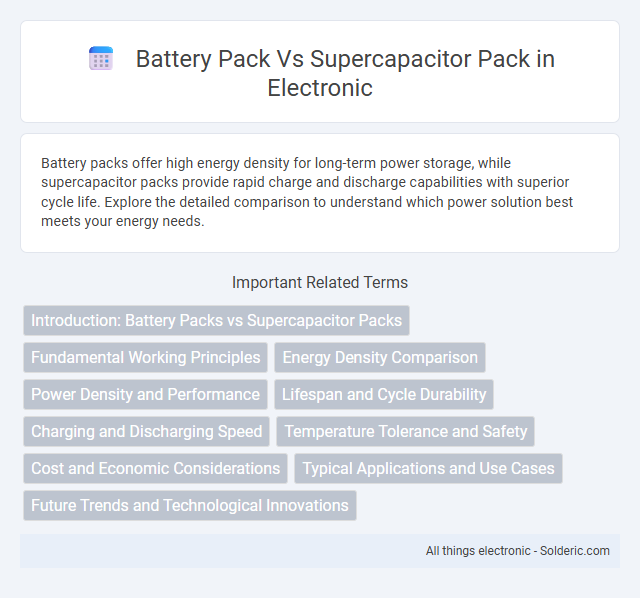Battery packs offer high energy density for long-term power storage, while supercapacitor packs provide rapid charge and discharge capabilities with superior cycle life. Explore the detailed comparison to understand which power solution best meets your energy needs.
Comparison Table
| Feature | Battery Pack | Supercapacitor Pack |
|---|---|---|
| Energy Density | High (100-265 Wh/kg) | Low (5-10 Wh/kg) |
| Power Density | Moderate (200-2000 W/kg) | Very High (up to 10,000 W/kg) |
| Charge/Discharge Rate | Slow to Moderate (1C to 3C) | Very Fast (up to 10,000 C) |
| Cycle Life | Moderate (500-2000 cycles) | Very High (up to 1,000,000 cycles) |
| Self-Discharge Rate | Low (1-5% per month) | High (up to 30% per month) |
| Operating Temperature Range | -20degC to 60degC | -40degC to 70degC |
| Typical Applications | Electric vehicles, portable electronics, grid storage | Power backup, regenerative braking, pulse power delivery |
| Weight | Heavier per energy stored | Lighter per power delivered |
| Cost | Moderate to High | High initial cost, lower long-term maintenance |
Introduction: Battery Packs vs Supercapacitor Packs
Battery packs store energy chemically, offering high energy density and prolonged discharge suitable for long-duration applications, while supercapacitor packs store energy electrostatically, delivering rapid charge and discharge rates with high power density ideal for short bursts of energy. Battery packs commonly use lithium-ion cells, providing energy capacities ranging from watt-hours to kilowatt-hours, whereas supercapacitor packs utilize activated carbon or graphene electrodes capable of millions of charge cycles. The choice between battery packs and supercapacitor packs depends on application requirements such as energy storage capacity, power delivery speed, lifecycle, and thermal management.
Fundamental Working Principles
Battery packs store energy chemically through electrochemical reactions within electrodes and electrolytes, enabling sustained energy release over time. Supercapacitor packs store energy physically by accumulating charge at the electrode-electrolyte interface via electric double layers, allowing rapid charge and discharge cycles. The fundamental distinction lies in batteries' reliance on chemical processes versus supercapacitors' dependence on electrostatic charge separation for energy storage.
Energy Density Comparison
Battery packs typically offer higher energy density, ranging from 100 to 250 Wh/kg, making them suitable for long-duration energy storage. Supercapacitor packs provide much lower energy density, often between 5 to 15 Wh/kg, but excel in power density and rapid charge/discharge cycles. The fundamental difference in electrochemical storage mechanisms results in batteries storing more energy in a compact form, while supercapacitors prioritize quick energy delivery over long-term storage.
Power Density and Performance
Battery packs generally offer higher energy density, making them suitable for applications requiring longer duration energy storage, but they have lower power density compared to supercapacitor packs. Supercapacitor packs excel in power density, providing rapid charge and discharge cycles with minimal degradation, ideal for high-power performance and short bursts of energy. Performance-wise, supercapacitors exhibit superior cycle life and thermal stability, while battery packs deliver sustained energy output for extended periods.
Lifespan and Cycle Durability
Battery packs typically offer a lifespan ranging from 500 to 2,000 charge cycles, with performance gradually degrading due to chemical wear and capacity loss. Supercapacitor packs provide exceptional cycle durability, often exceeding 1,000,000 charge-discharge cycles with minimal capacity reduction, making them ideal for applications requiring rapid and frequent energy discharge. The extended lifespan and robustness of supercapacitors result from their electrostatic energy storage mechanism, which avoids the chemical degradation seen in traditional batteries.
Charging and Discharging Speed
Battery packs typically exhibit slower charging and discharging speeds due to chemical energy storage mechanisms, with charging times ranging from 30 minutes to several hours. Supercapacitor packs enable rapid charging and discharging within seconds to minutes, leveraging electrostatic energy storage without chemical reactions. This significant difference makes supercapacitors ideal for applications requiring quick energy bursts and frequent cycling, while battery packs provide higher energy density but slower power delivery.
Temperature Tolerance and Safety
Supercapacitor packs exhibit superior temperature tolerance, operating effectively between -40degC to 65degC, while battery packs typically function within a narrower range of -20degC to 60degC. The inherent chemical stability of supercapacitors reduces the risk of thermal runaway and fire hazards, enhancing overall safety compared to lithium-ion battery packs. Your choice between these energy storage systems should consider the operational environment and safety requirements to ensure optimal performance.
Cost and Economic Considerations
Battery packs generally have a lower upfront cost compared to supercapacitor packs, making them more economically viable for applications requiring long-term energy storage. Supercapacitor packs, while more expensive initially, offer longer lifespans and superior charge-discharge efficiency, which can reduce replacement and maintenance costs over time. The total cost of ownership for supercapacitor packs may become favorable in high-cycle, rapid-charging environments despite their higher initial investment.
Typical Applications and Use Cases
Battery packs are essential in electric vehicles, portable electronics, and renewable energy storage systems due to their high energy density and longer discharge times. Supercapacitor packs excel in applications requiring rapid charge and discharge cycles, such as regenerative braking systems in trains, uninterruptible power supplies (UPS), and pulse power devices. The complementary use of both technologies is seen in hybrid systems where batteries provide sustained energy while supercapacitors handle peak power demands.
Future Trends and Technological Innovations
Battery packs are evolving with solid-state technology and advanced lithium-sulfur chemistries, offering higher energy density and longer lifespans for electric vehicles and portable electronics. Supercapacitor packs are integrating graphene-based materials and hybrid designs to enhance power delivery, rapid charging, and durability in applications requiring frequent energy bursts. Your choice between battery and supercapacitor packs will increasingly depend on specific energy storage needs as these future trends converge toward more efficient, scalable, and sustainable solutions.
Battery Pack vs Supercapacitor Pack Infographic

 solderic.com
solderic.com